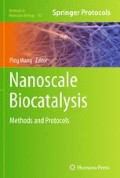Abstract
Many biocatalysts have been shown powerful in enabling reactions among a broad range of substrates possessing very different hydrophilicity/hydrophobicity. Biphasic reaction systems, especially oil–water biphasic systems, have been commonly adopted to mediate such reactions. The greatest challenge in conducting an efficient reaction between two substrates that have to be hosted in two immiscible liquid phases is the mass transfer resistance across interfaces. Imaginably, the substrates afford the most extensive interactions at the interfacial region. The interfacial assembled enzymes, developed by conjugating water-soluble enzymes with hydrophobic polymers, are therefore expected to be efficient in catalyzing biotransformation at the organic–aqueous interfaces. This chapter describes a method in preparing and applying of such interface-assembling enzymes. A model enzyme, α-chymotrypsin (CT), is grafted with polystyrene (PS) to introduce an organic affinity, thus leading to a surfactant-like structure. The characterization of the activity and stability of the interface-assembled enzyme is also presented.
Access this chapter
Tax calculation will be finalised at checkout
Purchases are for personal use only
References
Turner, M. K. (1995) Biocatalysis in organic chemistry (Part II): Present and future. Trends Biotechnol. 13, 253–258.
Koeller, K. M., and Wong, C. H. (2001) Enzymes for chemical synthesis. Nature 409, 232–240.
Loughlin, W. A. (2000) Biotransformation in organic synthesis. Bioresour. Technol. 74, 49–62.
Klibanov, A. M. (2001) Improving enzymes by using them in organic solvents. Nature 409, 246.
Blinkovsky, A. M., Martin, B. D., and Dordick, J. S. (1992) Enzymology in monophasic organic media. Curr. Opin. Biotechnol. 3, 124–129.
Halling, P. J. (2000) Biocatalysis in low-water media: Understanding effects of reaction conditions. Curr. Opin. Chem. Biol. 4, 74–80.
Colonna, S., Gaggero, N., Richelmi, C., and Pasta, P. (1999) Recent biotechnological developments in the use of peroxidases. Trends Biotechnol. 17, 163–168.
Palucki, M., Pospisil, P. J., Zhang, W., and Jacobsen, E. N. (1994) Highly enantioselective, low-temperature epoxidation of styrene. J. Am. Chem. Soc. 116, 9333–9334.
Ooi, Y., Hashimoto, T., Mitsuo, N., and Satoh, T. (1985) Enzymic formation of β-alkyl glycosides by β-galactosidase from Aspergillus oryzae and its application to the synthesis of chemically unstable cardiac glycosides. Chem. Pharm. Bull. 33, 1808–1814.
Okahata, Y., and Mori, T. (1998) Transglycosylation catalyzed by a lipid-coated β-D-galactosidase in a two-phase aqueous-organic system. J. Mol. Catal. B: Enzym. 5, 119–123.
Antonini, E., Carrea, G., and Cremonesi, P. (1981) Enzyme catalysed reactions in water – Organic solvent two-phase systems. Enzyme Microb. Technol. 3, 291–296.
Hickel, A., Radke, C. J., and Blanch, H. W. (1999) Hydroxynitrile lyase at the diisopropyl ether/water interface: Evidence for interfacial enzyme activity. Biotechnol. Bioeng. 65, 425–436.
Pier Luigi, L. (1985) Enzymes hosted in reverse micelles in hydrocarbon solution. Angew. Chem. Int. Ed. 24, 439–450.
Khmelnitsky, Y. L., Gladilin, A. K., Roubailo, V. L., Martinek, K., and Levashov, A. V. M. S. (1992) Reversed micelles of polymeric surfactants in nonpolar organic solvents. A new microheterogeneous medium for enzymatic reactions. Eur. J. Biochem. 206, 737–745.
Miyake, Y. (1996) Enzyme reaction in water-in-oil microemulsions. Colloids Surf. A 109, 255–262.
Halling, P. J. (1987) Biocatalysis in multi-phase reaction mixtures containing organic liquids. Biotechnol. Adv. 5, 47–84.
Chae, H. J., and Yoo, Y. J. (1997) Mathematical analysis of an enzymatic reaction in an aqueous/organic two-phase system: Tyrosinase-catalysed hydroxylation of phenol. J. Chem. Tech. Biotechnol. 70, 163–170.
Ross, A. C., Bell, G., and Halling, P. J. (2000) Organic solvent functional group effect on enzyme inactivation by the interfacial mechanism. J. Mol. Catal. B: Enzym. 8, 183–192.
Verger, R. (1980) Enzyme kinetics of lipolysis. In Methods in Enzymology (Purich, D. L., ed.), Academic Press, Orlando, FL, pp. 340–392.
Yampolskaya, G., and Platikanov, D. (2006) Proteins at fluid interfaces: Adsorption layers and thin liquid films. Adv. Colloid Interface Sci. 128–130, 159–183.
Milthorpe, B. K. (2005) Protein adsorption to surfaces and interfaces. In Surfaces and Interfaces for Biomaterials (Vadgama, P., ed.), Woodhead, Cambridge, pp. 763–781.
Wang, P., Woodward, C. A., and Kaufman, E. N. (1999) Poly(ethylene glycol)-modified ligninase enhances pentachlorophenol biodegradation in water-solvent mixtures. Biotechnol. Bioeng. 64, 290–297.
Vikram, M. P., and Dordick, J. S. (1994) Mechanism of extraction of chymotrypsin into isooctane at very low concentrations of aerosol OT in the absence of reversed micelles. Biotechnol. Bioeng. 43, 529–540.
Vazquez-Duhalt, R., Fedorak, P. M., and Westlake, D. W. S. (1992) Role of enzyme hydrophobicity in biocatalysis in organic solvents. Enzyme Microb. Technol. 14, 837–841.
Matsushita, M., Irino, T., Komoda, T., and Sakagishi, Y. (1993) Determination of proteins by a reverse biuret method combined with the copper-bathocuproine chelate reaction. Clin. Chim. Acta 216, 103–111.
Gabel, D. (1974) Active site titration of immobilized chymotrypsin with a fluorogenic reagent. FEBS Lett. 49, 280–281.
Delmar, E. G., Largman, C., Brodrick, J. W., and Geokas, M. C. (1979) A sensitive new substrate for chymotrypsin. Anal. Biochem. 99, 316–320.
Zhu, G., and Wang, P. (2004) Polymer–enzyme conjugates can self-assemble at oil/water interfaces and effect interfacial biotransformations. J Am. Chem. Soc. 126, 11132–11133.
Zhu, G., and Wang, P. (2005) Novel interface-binding chloroperoxidase for interfacial epoxidation of styrene. J. Biotechnol. 117, 195–202.
Acknowledgments
This work is supported by grants from the National Science Foundation (CTS-0214769) and the American Chemical Society PRF Program (36726-G4).
Author information
Authors and Affiliations
Corresponding author
Editor information
Editors and Affiliations
Rights and permissions
Copyright information
© 2011 Springer Science+Business Media, LLC
About this protocol
Cite this protocol
Zhu, G., Wang, P. (2011). Self-Assemblies of Polymer–Enzyme Conjugates at Oil–Water Interfaces for Interfacial Biocatalysis. In: Wang, P. (eds) Nanoscale Biocatalysis. Methods in Molecular Biology, vol 743. Humana Press. https://doi.org/10.1007/978-1-61779-132-1_3
Download citation
DOI: https://doi.org/10.1007/978-1-61779-132-1_3
Published:
Publisher Name: Humana Press
Print ISBN: 978-1-61779-131-4
Online ISBN: 978-1-61779-132-1
eBook Packages: Springer Protocols

